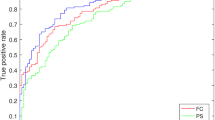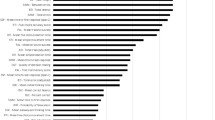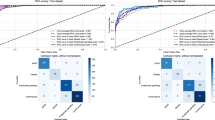Abstract
Attention-deficit/hyperactivity disorder (ADHD) is a common disabling psychiatric disorder associated with consistent deficits in error processing, inhibition and regionally decreased grey matter volumes. The diagnosis is based on clinical presentation, interviews and questionnaires, which are to some degree subjective and would benefit from verification through biomarkers. Here, pattern recognition of multiple discriminative functional and structural brain patterns was applied to classify adolescents with ADHD and controls. Functional activation features in a Flanker/NoGo task probing error processing and inhibition along with structural magnetic resonance imaging data served to predict group membership using support vector machines (SVMs). The SVM pattern recognition algorithm correctly classified 77.78 % of the subjects with a sensitivity and specificity of 77.78 % based on error processing. Predictive regions for controls were mainly detected in core areas for error processing and attention such as the medial and dorsolateral frontal areas reflecting deficient processing in ADHD (Hart et al., in Hum Brain Mapp 35:3083–3094, 2014), and overlapped with decreased activations in patients in conventional group comparisons. Regions more predictive for ADHD patients were identified in the posterior cingulate, temporal and occipital cortex. Interestingly despite pronounced univariate group differences in inhibition-related activation and grey matter volumes the corresponding classifiers failed or only yielded a poor discrimination. The present study corroborates the potential of task-related brain activation for classification shown in previous studies. It remains to be clarified whether error processing, which performed best here, also contributes to the discrimination of useful dimensions and subtypes, different psychiatric disorders, and prediction of treatment success across studies and sites.


Similar content being viewed by others
References
Albrecht B, Brandeis D, Uebel H, Heinrich H, Mueller UC, Hasselhorn M, Steinhausen HC, Rothenberger A, Banaschewski T (2008) Action monitoring in boys with attention-deficit/hyperactivity disorder, their nonaffected siblings, and normal control subjects: evidence for an endophenotype. Biol Psychiatry 64:615–625
Amico F, Stauber J, Koutsouleris N, Frodl T (2011) Anterior cingulate cortex gray matter abnormalities in adults with attention deficit hyperactivity disorder: a voxel-based morphometry study. Psychiatry Res Neuroimag 191:31–35
APA (2000) DSM IV: Diagnositic and statistical manual of mental disorders. American Psychiatric Press, Washington DC
Ashburner J (2007) A fast diffeomorphic image registration algorithm. Neuroimage 38:95–113
Ashburner J, Friston KJ (2000) Voxel-Based Morphometry—the Methods. Neuroimage 11:805–821
Boser BE, Guyon IM, Vapnik VN (1992) A training algorithm for optimal margin classifiers. Proceedings of the fifth annual workshop on Computational learning theory. ACM, Pittsburgh, pp 144–152
Bush G (2010) Attention-deficit/hyperactivity disorder and attention networks. Neuropsychopharmacology 35:278–300
Bush G, Spencer TJ, Holmes J et al (2008) Functional magnetic resonance imaging of methylphenidate and placebo in attention-deficit/hyperactivity disorder during the multi-source interference task. Arch Gen Psychiatry 65:102–114
Carmona S, Vilarroya O, Bielsa A, Tremols V, Soliva JC, Rovira M, Tomas J, Raheb C, Gispert JD, Batlle S, Bulbena A (2005) Global and regional gray matter reductions in ADHD: a voxel-based morphometric study. Neurosci Lett 389:88–93
Castellanos FX, Di Martino A, Craddock RC, Mehta AD, Milham MP (2013) Clinical applications of the functional connectome. NeuroImage 80:527–540
Castellanos FX, Lee PP, Sharp W, Jeffries NO, Greenstein DK, Clasen LS, Blumenthal JD, James RS, Ebens CL, Walter JM, Zijdenbos A, Evans AC, Giedd JN, Rapoport JL (2002) Developmental trajectories of brain volume abnormalities in children and adolescents with attention-deficit/hyperactivity disorder. JAMA 288:1740–1748
Conners CK, Sitarenios G, Parker JA, Epstein J (1998) The revised conners’ parent rating scale (CPRS-R): factor structure, reliability, and criterion validity. J Abnorm Child Psychol 26:257–268
Cubillo A, Halari R, Smith A, Taylor E, Rubia K (2012) A review of fronto-striatal and fronto-cortical brain abnormalities in children and adults with Attention Deficit Hyperactivity Disorder (ADHD) and new evidence for dysfunction in adults with ADHD during motivation and attention. Cortex 48:194–215
Debener S, Ullsperger M, Siegel M, Fiehler K, von Cramon DY, Engel AK (2005) Trial-by-trial coupling of concurrent electroencephalogram and functional magnetic resonance imaging identifies the dynamics of performance monitoring. J Neurosci 25:11730–11737
Durston S, de Zeeuw P, Staal WG (2009) Imaging genetics in ADHD: a focus on cognitive control. Neurosci Biobehav Rev 33:674–689
Ecker C, Marquand A, Mourão-Miranda J, Johnston P, Daly EM, Brammer MJ, Maltezos S, Murphy CM, Robertson D, Williams SC, Murphy DGM (2010) Describing the brain in autism in five dimensions—magnetic resonance imaging-assisted diagnosis of autism spectrum disorder using a multiparameter classification approach. J Neurosci 30:10612–10623
Eloyan A, Muschelli J, Nebel MB, Liu H, Han F, Zhao T, Barber AD, Joel S, Pekar JJ, Mostofsky SH, Caffo B (2012) Automated diagnoses of attention deficit hyperactive disorder using magnetic resonance imaging. Front Syst Neurosci 6:61
Eppinger B, Mock B, Kray J (2009) Developmental differences in learning and error processing: evidence from ERPs. Psychophysiology 46:1043–1053
Eriksen BA, Eriksen CW (1974) Effect of noise letters upon the identification of a target letter in a nonsearch task. Percept Psychophys 16:143–149
Faraggi D, Reiser B (2002) Estimation of the area under the ROC curve. Stat Med 21:3093–3106
Friston KJ, Holmes AP, Worsley KJ, Poline JP, Frith CD, Frackowiak RSJ (1994) Statistical parametric maps in functional imaging: a general linear approach. Hum Brain Mapp 2:189–210
Frodl T, Skokauskas N (2012) Meta-analysis of structural MRI studies in children and adults with attention deficit hyperactivity disorder indicates treatment effects. Acta Psychiatr Scand 125:114–126
Garavan H, Ross TJ, Kaufman J, Stein EA (2003) A midline dissociation between error-processing and response-conflict monitoring. Neuroimage 20:1132–1139
Geburek AJ, Rist F, Gediga G, Stroux D, Pedersen A (2013) Electrophysiological indices of error monitoring in juvenile and adult attention deficit hyperactivity disorder (ADHD)—a meta-analytic appraisal. Int J Psychophysiol 87:349–362
Giuliani NR, Calhoun VD, Pearlson GD, Francis A, Buchanan RW (2005) Voxel-based morphometry versus region of interest: a comparison of two methods for analyzing gray matter differences in schizophrenia. Schizophr Res 74:135–147
Golland P, Fischl B (2003) Permutation tests for classification: towards statistical significance in image-based studies. In: Taylor C, Noble JA (eds) Information Processing in Medical Imaging. Springer, Berlin Heidelberg, pp 330–341
Hart H, Chantiluke K, Cubillo AI, Smith AB, Simmons A, Brammer MJ, Marquand AF, Rubia K (2014) Pattern classification of response inhibition in ADHD: toward the development of neurobiological markers for ADHD. Hum Brain Mapp 35:3083–3094
Hart H, Marquand AF, Smith A, Cubillo A, Simmons A, Brammer M, Rubia K (2014) Predictive neurofunctional markers of attention-deficit/hyperactivity disorder based on pattern classification of temporal processing. J Am Acad Child Adolesc Psychiatry 53(569–578):e561
Hastie T, Tibshirani R, Friedman JH (2003) The elements of statistical learning. Springer, New York
Hauser TU, Iannaccone R, Ball J, Mathys C, Brandeis D, Walitza S, Brem S (2014) Role of the medial prefrontal cortex in impaired decision making in juvenile attention-deficit/hyperactivity disorder. JAMA Psychiatry 71:1165–1173
Hauser TU, Iannaccone R, Stampfli P, Drechsler R, Brandeis D, Walitza S, Brem S (2014) The feedback-related negativity (FRN) revisited: new insights into the localization, meaning and network organization. Neuroimage 84:159–168
Heinrich H, Hoegl T, Moll GH, Kratz O (2014) A bimodal neurophysiological study of motor control in attention-deficit hyperactivity disorder: a step towards core mechanisms? Brain J Neurol 137:1156–1166
Iannaccone R, Hauser TU, Staempfli P, Walitza S, Brandeis D, Brem S (2015) Conflict monitoring and error processing: new insights from simultaneous EEG–fMRI. Neuroimage 105:395–407
Kaufman J, Birmaher B, Brent D, Rao U, Flynn C, Moreci P, Williamson D, Ryan N (1997) Schedule for Affective Disorders and Schizophrenia for School-Age Children-Present and Lifetime Version (K-SADS-PL): initial reliability and validity data. J Am Acad Child Adolesc Psychiatry 36:980–988
Kloppel S, Abdulkadir A, Jack CR Jr, Koutsouleris N, Mourao-Miranda J, Vemuri P (2012) Diagnostic neuroimaging across diseases. NeuroImage 61:457–463
Li F, Huang X, Tang W, Yang Y, Li B, Kemp GJ, Mechelli A, Gong Q (2014) Multivariate pattern analysis of DTI reveals differential white matter in individuals with obsessive-compulsive disorder. Hum Brain Mapp 35:2643–2651
Lim L, Marquand A, Cubillo AA, Smith AB, Chantiluke K, Simmons A, Mehta M, Rubia K (2013) Disorder-specific predictive classification of adolescents with attention deficit hyperactivity disorder (ADHD) relative to autism using structural magnetic resonance imaging. PLoS ONE 8:e63660
Liotti M, Pliszka SR, Perez R, Kothmann D, Woldorff MG (2005) Abnormal brain activity related to performance monitoring and error detection in children with ADHD. Cortex 41:377–388
Marquand A, Howard M, Brammer M, Chu C, Coen S, Mourao-Miranda J (2010) Quantitative prediction of subjective pain intensity from whole-brain fMRI data using Gaussian processes. Neuro Image 49:2178–2189
Marquand A, Rondina J, Mourao-Miranda J, Rocha-Rego V, Giampietro V Manual: Pattern Recognition of Brain Image Data—PROBID. Version 1.03
Mayes SD, Calhoun SL, Mayes RD, Molitoris S (2012) Autism and ADHD: overlapping and discriminating symptoms. Res Autism Spectr Disord 6:277–285
Misaki M, Luh W-M, Bandettini PA (2013) The effect of spatial smoothing on fMRI decoding of columnar-level organization with linear support vector machine. J Neurosci Methods 212:355–361
Modinos G, Mechelli A, Pettersson-Yeo W, Allen P, McGuire P, Aleman A (2013) Pattern classification of brain activation during emotional processing in subclinical depression: psychosis proneness as potential confounding factor. Peer J 1:e42
Modinos G, Pettersson-Yeo W, Allen P, McGuire PK, Aleman A, Mechelli A (2012) Multivariate pattern classification reveals differential brain activation during emotional processing in individuals with psychosis proneness. Neuroimage 59:3033–3041
Mørch N, Hansen L, Strother S, Svarer C, Rottenberg D, Lautrup B, Savoy R, Paulson O (1997) Nonlinear versus linear models in functional neuroimaging: learning curves and generalization crossover. In: Duncan J, Gindi G (eds) Information Processing in Medical Imaging. Springer, Berlin Heidelberg, pp 259–270
Mourao-Miranda J, Bokde AL, Born C, Hampel H, Stetter M (2005) Classifying brain states and determining the discriminating activation patterns: support Vector Machine on functional MRI data. Neuro Image 28:980–995
Mourao-Miranda J, Ecker C, Sato JR, Brammer M (2008) Dynamic changes in the mental rotation network revealed by pattern recognition analysis of fMRI data. J Cognit Neurosci 21:890–904
Mourao-Miranda J, Reinders AATS, Rocha-Rego V, Lappin J, Rondina J, Morgan C, Morgan KD, Fearon P, Jones PB, Doody GA, Murray RM, Kapur S, Dazzan P (2012) Individualized prediction of illness course at the first psychotic episode: a support vector machine MRI study. Psychol Med 42:1037–1047
Nakao T, Nakao J, Radua K, Rubia D, Mataix C (2011) Gray matter volume abnormalities in ADHD: voxel-based meta-analysis exploring the effects of age and stimulant medication. Am J Psychiatry 168:1154
Oliveira L, Ladouceur CD, Phillips ML, Brammer M, Mourao-Miranda J (2013) What does brain response to neutral faces tell us about major depression? evidence from machine learning and fMRI. PLoS ONE 8:e60121
Op de Beeck HP (2010) Against hyperacuity in brain reading: spatial smoothing does not hurt multivariate fMRI analyses? Neuroimage 49:1943–1948
Orru G, Pettersson-Yeo W, Marquand AF, Sartori G, Mechelli A (2012) Using Support Vector Machine to identify imaging biomarkers of neurological and psychiatric disease: a critical review. Neurosci Biobehav Rev 36:1140–1152
Peng X, Lin P, Zhang T, Wang J (2013) Extreme learning machine-based classification of ADHD using brain structural MRI data. PLoS ONE 8:e79476
Pliszka SR, Glahn DC, Semrud-Clikeman M, Franklin C, Perez R 3rd, Xiong J, Liotti M (2006) Neuroimaging of inhibitory control areas in children with attention deficit hyperactivity disorder who were treatment naive or in long-term treatment. Am J Psychiatry 163:1052–1060
Pliszka SR, Lancaster J, Liotti M, Semrud-Clikeman M (2006) Volumetric MRI differences in treatment-naïve vs chronically treated children with ADHD. Neurology 67:1023–1027
Pliszka SR, Liotti M, Bailey BY, Perez R 3rd, Glahn D, Semrud-Clikeman M (2007) Electrophysiological effects of stimulant treatment on inhibitory control in children with attention-deficit/hyperactivity disorder. J Child Adolesc Psychopharmacol 17:356–366
Polanczyk G, de Lima MS, Horta BL, Biederman J, Rohde LA (2007) The worldwide prevalence of ADHD: a systematic review and metaregression analysis. Am J Psychiatry 164:942–948
Rubia K (2007) Neuro-anatomic evidence for the maturational delay hypothesis of ADHD. Proc Natl Acad Sci 104:19663–19664
Rubia K, Cubillo A, Smith AB, Woolley J, Heyman I, Brammer MJ (2010) Disorder-specific dysfunction in right inferior prefrontal cortex during two inhibition tasks in boys with attention-deficit hyperactivity disorder compared to boys with obsessive–compulsive disorder. Hum Brain Mapp 31:287–299
Rubia K, Halari R, Cubillo A, Mohammad AM, Brammer M, Taylor E (2009) Methylphenidate normalises activation and functional connectivity deficits in attention and motivation networks in medication-naive children with ADHD during a rewarded continuous performance task. Neuropharmacology 57:640–652
Rubia K, Smith AB, Brammer MJ, Toone B, Taylor E (2005) Abnormal brain activation during inhibition and error detection in medication-naive adolescents with ADHD. Am J Psychiatry 162:1067–1075
Semrud Clikeman M, Pliszka S, Bledsoe J, Lancaster J (2012) Volumetric MRI Differences in Treatment Naive and Chronically Treated Adolescents With ADHD-Combined Type. J Atten Disord 18:511–520
Semrud-Clikeman M, Pliszka SR, Lancaster J, Liotti M (2006) Volumetric MRI differences in treatment-naive vs chronically treated children with ADHD. Neurology 67:1023–1027
Shaw P, Eckstrand K, Sharp W, Blumenthal J, Lerch JP, Greenstein D, Clasen L, Evans A, Giedd J, Rapoport JL (2007) Attention-deficit/hyperactivity disorder is characterized by a delay in cortical maturation. Proc Natl Acad Sci 104:19649–19654
Slotnick SD, Moo LR, Segal JB, Hart J Jr (2003) Distinct prefrontal cortex activity associated with item memory and source memory for visual shapes. Brain Res Cogn Brain Res 17:75–82
Sordo M, Zeng Q (2005) On sample size and classification accuracy: a performance comparison. In: Oliveira J, Maojo V, Martín-Sánchez F, Pereira A (eds) Biological and medical data analysis. Springer, Berlin Heidelberg, pp 193–201
Swisher JD, Gatenby JC, Gore JC, Wolfe BA, Moon C-H, Kim S-G, Tong F (2010) Multiscale pattern analysis of orientation-selective activity in the primary visual cortex. J Neurosci 30:325–330
Ullsperger M, von Cramon DY (2001) Subprocesses of performance monitoring: a dissociation of error processing and response competition revealed by event-related fMRI and ERPs. Neuroimage 14:1387–1401
Van Veen V, Carter CS (2002) The timing of action-monitoring processes in the anterior cingulate cortex. J Cogn Neurosci 14:593–602
Vapnik VN (2000) The nature of statistical learning theory. Springer, New York
Velanova K, Wheeler ME, Luna B (2008) Maturational changes in anterior cingulate and frontoparietal recruitment support the development of error processing and inhibitory control. Cereb Cortex 18:2505–2522
Waldmann H-C (2008) Kurzformen des HAWIK-IV: statistische Bewertung in verschiedenen Anwendungsszenarien. Diagnostica 54:202–210
Weiler MD, Bellinger D, Simmons E, Rappaport L, Urion DK, Mitchell W, Bassett N, Burke PJ, Marmor J, Waber D (2000) Reliability and validity of a DSM-IV based ADHD screener. Child Neuropsychol 6:3–23
WHO (2010) International Classification of Diseases (ICD-10)
Zhu C-Z, Zang Y-F, Cao Q-J, Yan C-G, He Y, Jiang T-Z, Sui M-Q, Wang Y-F (2008) Fisher discriminative analysis of resting-state brain function for attention-deficit/hyperactivity disorder. Neuroimage 40:110–120
Acknowledgments
This study was supported by Swiss National Science Foundation grant (No. 320030_130237) and the Hartmann Mueller Foundation (No. 1,460). We thank Julia Frey and Maya Schneebeli for assistance with MR-measurements, recruitment and administrative work, Carolin Knie for help with clinical interviews, and Philipp Staempfli and Marco Piccirelli for their helpful inputs on our MR-sequence. We thank the anonymous reviewers for their helpful suggestions to improve this article.
Conflict of interest
S. Walitza received speakers’ honoraria from Eli Lilly, Opo-Pharma, Janssen-Cilag and AstraZeneca in the last 5 years.
Author information
Authors and Affiliations
Corresponding author
Electronic supplementary material
Below is the link to the electronic supplementary material.
Rights and permissions
About this article
Cite this article
Iannaccone, R., Hauser, T.U., Ball, J. et al. Classifying adolescent attention-deficit/hyperactivity disorder (ADHD) based on functional and structural imaging. Eur Child Adolesc Psychiatry 24, 1279–1289 (2015). https://doi.org/10.1007/s00787-015-0678-4
Received:
Accepted:
Published:
Issue Date:
DOI: https://doi.org/10.1007/s00787-015-0678-4




